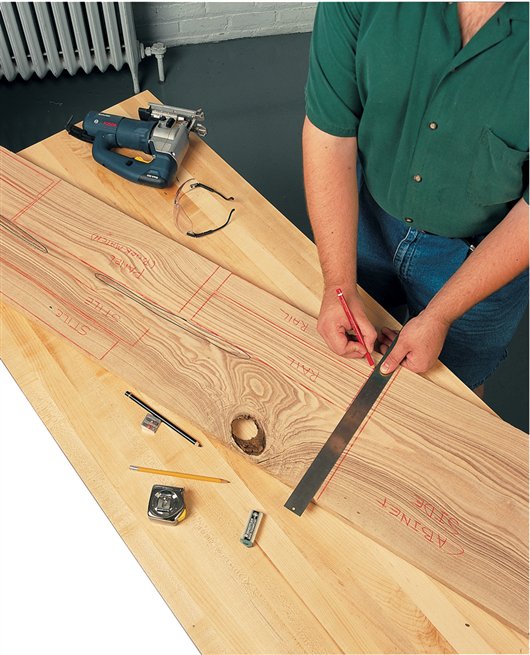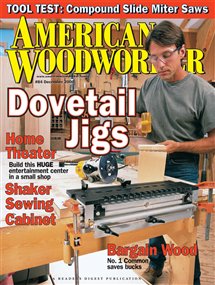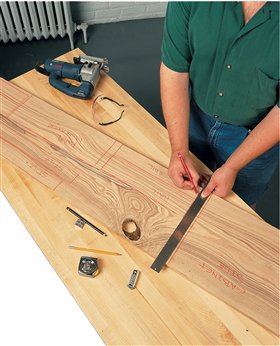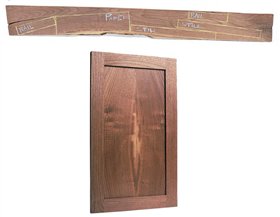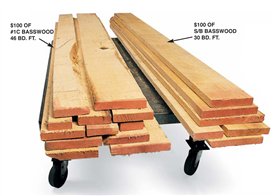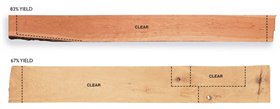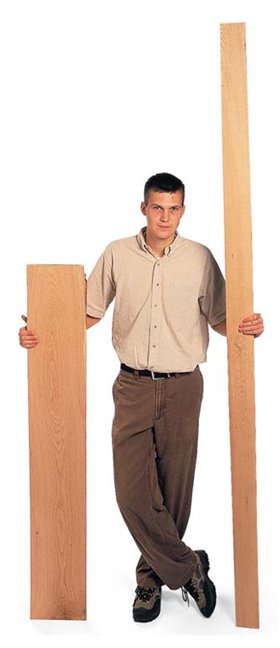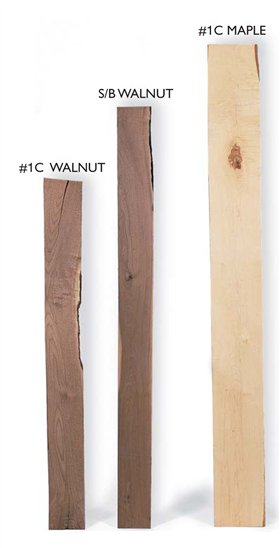|
Want to make your head spin?
Just try to figure out how hardwood
lumber is graded.Lumber is such
an incredibly diverse material that there
are enough grades, rules for grading
and exceptions to the rules to make
you dizzy.Professional lumber graders
use standards, administered by the
National Hardwood Lumber Association,
to classify every board.While you
don’t need to be a pro, knowing the
difference between No. 1 Common and
the higher “select”grades can keep you
from wasting your money.
Everybody likes to buy “the best.”But
when choosing lumber, it’s a mistake to
pay top dollar for big, clear boards if
you’re going to cut them up into small
pieces.The best boards to buy aren’t
always the most expensive ones.
No. 1 Common is great for furniture
Take a look at No. 1 Common lumber.
It costs a lot less than the higher grades
because the boards are smaller and
they’ve got some knots and other
defects.They also contain a lot of perfectly
clear material.You just have to be
willing to buy a little extra stock and
spend some time working with it. It
can be a challenge to figure out how to
harvest the pieces you need, but it’s
also enjoyable and rewarding when
you do.
No. 1 Common lumber is well suited
to furniture making. It’s an economical
source for narrow stock, perfect for
moldings, or stiles and rails for face
frames and frame-and-panel structures
like doors or cabinet sides.You’ll
also find boards in the common pile
that are wide, with enough clear
lengths between defects to make goodlooking
panels, cabinet sides or small
tabletops.
You can find treasure boards in No.1 Common.
No. 1 Common lumber often contains
striking grain and figure patterns that
are usually absent in the select grades.
That’s because these “abnormalities” often occur around knots and near
other natural defects.With selective or
innovative cutting, you can remove and
showcase them.Or perhaps you prefer
a look that includes knots, splits and
natural edges. Common grade boards
can be downright beautiful, making
more expensive higher grade boards
look plain by comparison!
The real difference: a pretty face
When you look at a chart of the various
lumber grades (Fig.A, below), No. 1
Common appears to be a full step lower
than Selects and Better. But look
closely—the difference is really only a
half step.
First, Selects and Better (the highest grade you’re likely to see at most lumberyards)
isn’t the highest grade. It’s a combination of the
top three grades (think Selects and better).To
make Selects and Better, boards only need to
meet the minimum requirements of Selects.
Second, boards are always graded on
both faces. Here’s the rub: To grade
Selects,only one face of a board has to
make the top grade (Firsts and Seconds;
another combination). The
other face only has to make No. 1
Common.That means the difference
between No. 1 Common and Selects and
Better is one (good) face!
The nature of No. 1 Common lumber
No. 1 Common boards usually come from the
interior of large logs or from small logs. The
center of a log, or pith, is unusable. Boards cut
near the pith contain more defects. Boards
from small logs are either narrow or cut close
to the pith.
Expect to find these defects, alone or in
combination, when you look at No. 1 common:
• Knots.The boards are likely to have several
knots, clustered, loose or even open.
• Bark. There’ll be edges containing bark
(wane), including up to one third of a board’s
width and up to half of its length. Light-colored
sapwood, typical in cherry (shown) and walnut,
isn’t considered a defect when grading.You’ll just
find more of it in No.1 Common because of the
smaller logs.
• Bad ends. All it takes to drop a board into
No. 1 Common grade is one bad end. Long or
numerous checks and clusters of knots that
extend more than 12 in. are typical.
• Warp.The boards can be bowed, crooked,
cupped or twisted, as long as the clear cuttings
from them can be planed flat on two sides to the
standard surfaced thickness (13/16 in. for 1-in.
rough stock, for example).
While having a good face is important, the closeness
in quality between these grades, compared with
the difference in price,makes No. 1 Common worth
considering.Remember, just as some of those expensive
Selects and Better boards are going to have one
No. 1 Common side, some of the cheaper No. 1 Common
boards may have one face that’s a gem.
When selects and better is better
It makes sense to buy big,defect-free boards for big,
smooth surfaces, such as table- or desktops, plankstyle
cabinet sides or perhaps a head- or footboard.
A group of Selects and Better boards may have more
consistent color and grain patterns. Defect-free
boards are less distracting to look at and generally
easier to work with.Working with No. 1 Common
takes time and patience.
Fig. A: Basic Grade Requirements for Hardwoods

The National Hardwood Lumber Association’s grading
standards are based on the assumption that every board will
be cut into defect-free pieces, called “cuttings,” for use as
furniture components.
A board’s grade depends on the number and size of the clear
pieces it contains. Aesthetics aren’t considered.
This story originally appeared in American Woodworker December 2000, issue #84.

December 2000, issue #84
Purchase this back issue.
|
|
Click any image to view a larger version.

Defects don't make a board defective; just cheaper. If your project calls for
small parts, like stiles and rails, lumber that’s graded No. 1 Common is an economical
choice.You can harvest perfectly good pieces by cutting around the knots.

Finding hidden beauty in an unsightly board is rewarding and well worth the
head-scratching it takes. In spite of serious end checks, an awkward grain pattern and
a waney edge, the $8 piece of No. 1 Common walnut shown above contains all the
parts for an eye-catching cabinet door.There’s straight grain for stiles and rails and a
piece that, when resawn, made a great bookmatched panel.No. 1 Common boards
often contain unusual grain and interesting color and figure. Because these usually
occur around defects, you aren’t as likely to find them in the higher (clearer) grades.

Get more wood for your money! Depending on the
species, No. 1 Common lumber typically costs 25- to 40-
percent less than the next higher grade, Selects and Better.
There are two reasons for this: availability and desirability.
No. 1 Common boards are cheap because the raw material is
plentiful. Most of the boards cut from a log contain too many
natural defects to make the top grades, and boards without
defects are rare. No. 1 Common boards cost less because
they contain a fair amount of unusable material.You get a
price break because you have to buy up to 30 percent more
to compensate for the waste. Don’t worry! The math usually
works out in your favor. Buying No. 1 Common is almost
always cheaper.

Expect less clear lumber, but don’t be surprised when you get more.
No. 1 Common grade allows defects to occupy up to one third of the board.
But like any grade, it contains boards that barely qualify (bottom) and boards
that just missed being graded higher (top).

Some No. 1 Common is very clear, but simply
short or narrow. If a board is under 6-ft. long, or less
than 4-in. wide, it won’t qualify for a higher grade.

Dark-colored heartwood,
typical in maple, birch and ash, isn’t
considered a defect unless the board is
also specifically graded for light color.
You’ll find considerable dark-colored
heartwood in No. 1 Common grades of
these species, just as you’ll find more
light-colored sapwood in No. 1 Common
cherry and walnut.

Lower grading standards apply to walnut and its close cousin
butternut, allowing smaller boards and more defects.And unlike other
species, the best side of a walnut board is used to determine its grade. In
general, grading rules are tailored to specific species.Walnut trees usually
don’t get to be giants, so the typical log is undersized.That fact is considered
when the boards are graded.
|



